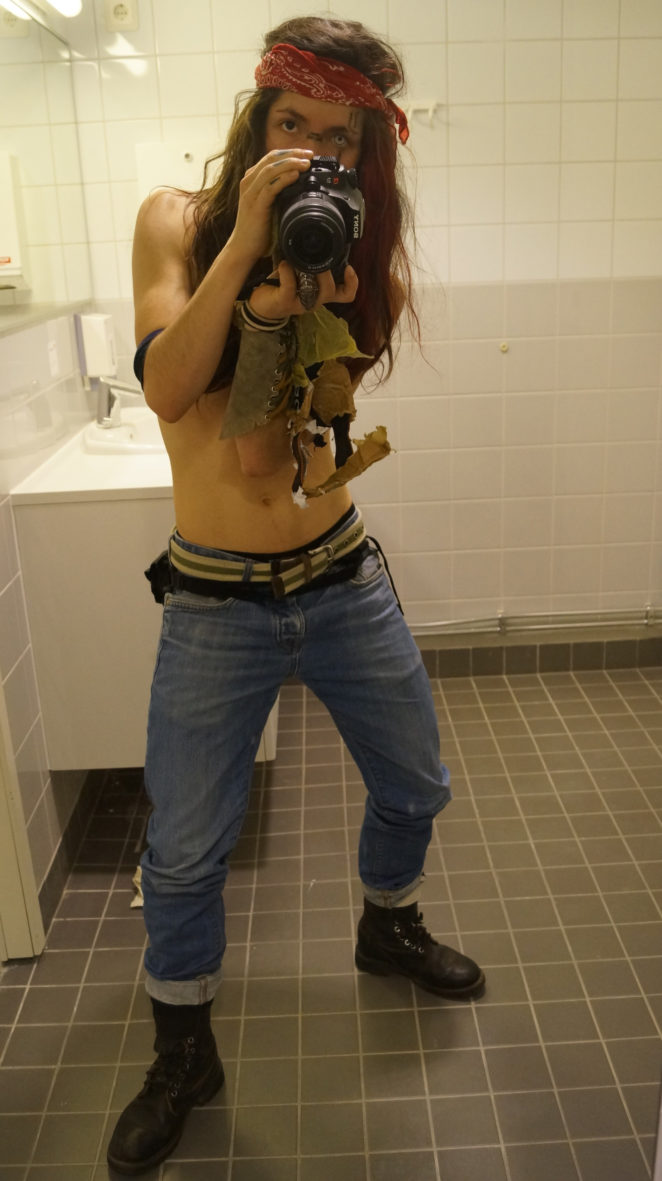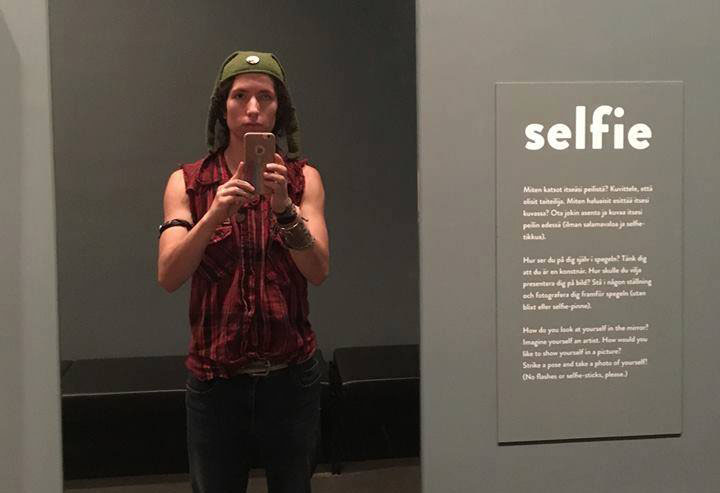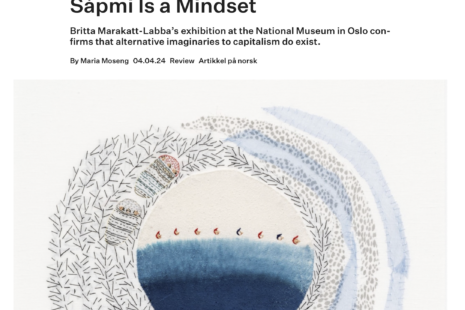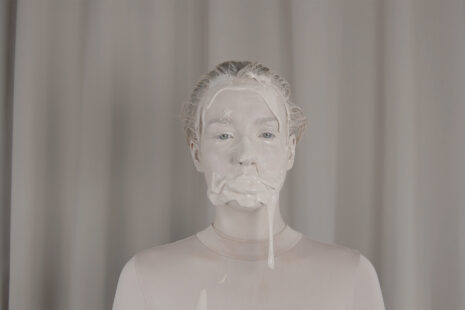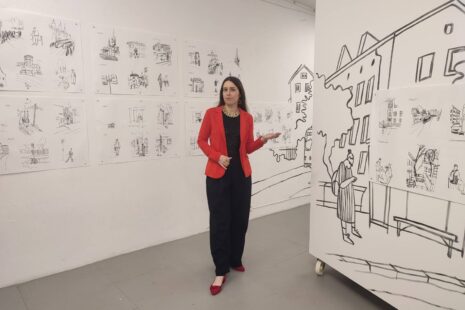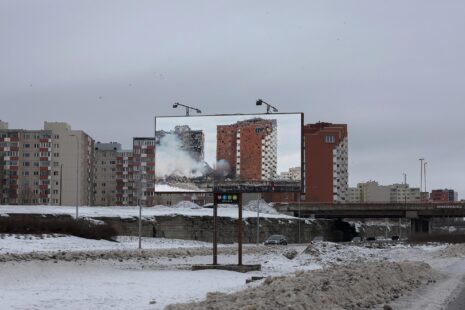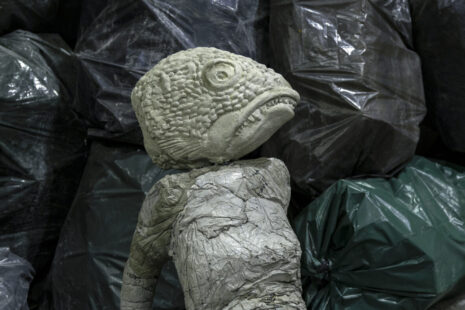First of all, congratulations! How do you feel about winning the main prize of NBYAA – was the Grand Prix a surprise?
It arrived at a perfect moment for me for, to be honest, I was feeling discouraged and quite low about my art and things in general. I was also in a position in my artistic life where I was just applying and applying for exhibitions having an endless suite of refusals because – as they said – I don’t “fit”.
It seemed I was like the red stain on a white wall when curators were looking for artists that would make sense together.
But I felt incredibly happy for I am also having a lot of personal struggles trying to transition as a transgender man what involves a lot of issues with a lot of people who don’t know so much about a minority at a medical, family and paperwork level as extra when trying to graduate and going on with my quite intense dance and music training.
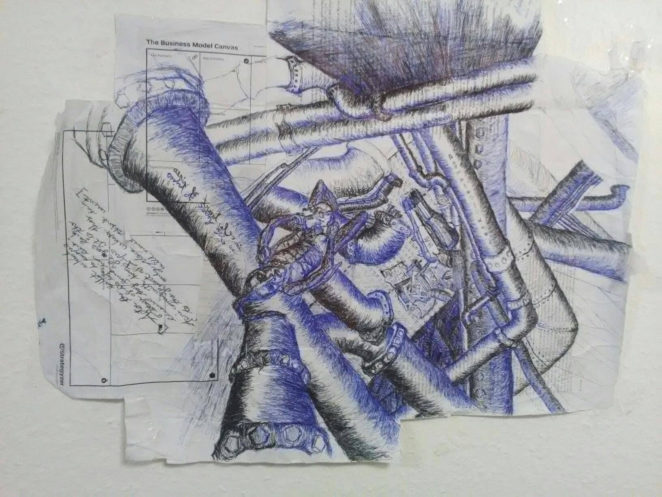
Rag Elnyg artwork. Photo courtesy of artist
What is most important to you about the prize?
I have been told once, “there is no such thing as contemporary art but just artists”. I was feeling, even though relating to that sentence, that something didn’t work for me. That I was “aside”. That a lot of things, important for others weren’t for me and contrariwise regarding one’s practice. It has been hard to understand that if I really want to play music, dance and to give life to figurative teenage-like stories in the field of contemporary art. It is possible.
This award helped me to see that the path I want to follow might not be as lonely as I thought. That people are feeling moved and appreciate what I do. This has been really meaningful.
Secondly, having obtained my bachelor degree in France, it has been really liberating to sense more space and Freedom in Kuvataideakatemia for simply creating. To be able to access a space available 24 hours 7 days a week where I can play and practice and put nails in the wall whenever I want without it being a problem for others. It can appear like little things but really, it is a luxury.
I have been physically born and delivered by my mother in France as a human being but I have been born again as a man and the artist in Finland. So to win the Nordic and Baltic Young Artist Award representing Kuvataideakatemia means a lot to me.
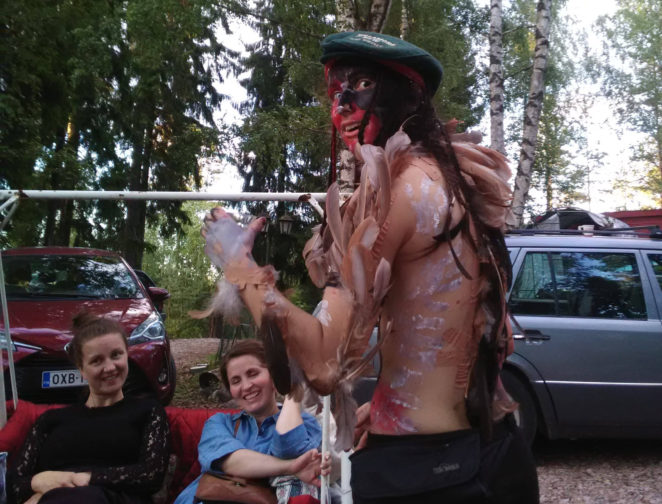
Photo courtesy of artist
Has art and being an artist always been the only option for you? How did you find your way into the field?
When average parents generally tell: “Art? Are you sure you don’t want to study something useful? Economy for example?”, then mine told me: “Ok, you do a bachelor of languages, fine. But when are you going to apply for art school?” My mother is an art history teacher, my father an art therapist, my grandfather, grandmother, her father and grandfather are or have been plastic artists, so I have been drawing since I could hold a pen. I can’t remember not being able to draw. However, I am stubborn, and I was considering art as a “family disorder” like my mother before me when she tried to study biology. In a similar way, I studied Spanish and English in the field of translation for business. In fact, I ended up studying enough to graduate but spending my time covering my walls with paintings in a 10 m square in Lyon. I went on exchange in Mexico for my last language bachelor year and when I came back, I decided to study plastic arts. Music came much later.
There are very few musicians in my family. One of my cousins is singing in a punk band and has been a string instrument maker. He is the one who repaired my great-great grandfather’s violin. The one I tried to learn on my own. But craving for learning music in a non-musical family wasn’t easy and had me experiencing similar struggles some friends in the field of art have with their family.
Contemporary art gives me freedom and innocence as a musician that I would never have in music school and which I never felt with plastic arts.
The term “artist” has been hard for me to own and handle. I prefer to think of myself as a poet.
It comes from the ancient Greek ποιεῖν: “poiein” which basically means “ to make” – a poet is someone who makes things. And it is the only term I can think about where all the fields of my practice fit.
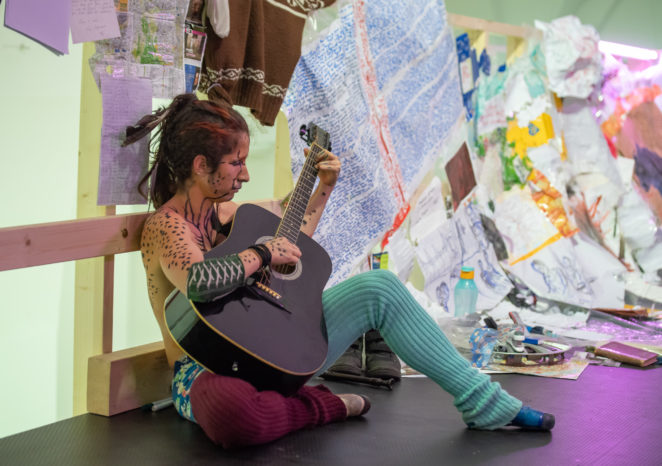
Photo courtesy of Ivar Hütt
What inspires you to create your pieces?
This is a delicate question to answer because I don’t really know myself, yet. A year and a half ago, I came out as a transgender man and am still transitioning. I should start hormone therapy next spring, so I feel I am still a bit artistically stuck in a “self-portrait” stage. Indeed, I don’t look yet like a man for most people, so I feel I am not free to dress the way I want to or have my mind free of this situation.
Most of my drawings, symbols, body paint, dance sign language, and cloth pieces are from story. Auri and Nick are characters from the first part of a set of heroic fantasy books I am writing and drawing since I was 12 or 13. They take place in two stages of a dystopian future on earth as well as in another world with other civilizations, languages, fauna, flora, and concepts I craft along the way.
But then, my work is layered, there are different levels of depths and it depends on the viewer how deep they want to go. A lot of content can also be skimmed through and I like the idea that the viewer is free to interpret and obtain what they feel they like.
Your submitted work combined performance and installation. Please describe it shortly – what was it about?
One thing that inspires me is learning. The performances and the installation are linked but not exactly belonging to the same process, the installation being a mix between my “outer life” (receipts from things I buy, feelings I need to write down etc) and “inner life” (the heroic fantasy-like stories I live within my soul, random texts, drawing and poems…)
Another part of my work is trying to acquire skills thanks to YouTube tutorials and make video journeys about them that I publish back on YouTube or Vimeo (Channel name: Rag Elnyg). Trying to become left-handed or trying to give personality to my toes, learning violin.
The performances are the outcome of the current stage I am of my diverse apprenticeships. They are called “TarinaT” as a series, but they are each one telling a tale of their own.
What would you like audience to see and understand when they see your works?
One thing I would like my audience to understand is that it is ok if they don’t understand. I work with many languages and as average, the people who watch me perform don’t speak them all fluently, not even myself. But I think we don’t need to fully understand something to appreciate it and very often our strong conviction we do understand leaves us blind on how much we still don’t and have to learn.
The performance and the installation put together symbolizes that we don’t have to apply for an average “human like” life if we don’t want to. For example, I don’t feel human every day. Mankind is a concept for me. A concept I don’t relate to very often. But thanks to performance, I understood that as long as I pay my bills and behave like a human every now and then, I can be more free than I ever thought it was possible to be. This is what I would like to transmit as much as possible.
In my opinion, too many people tend to think they are doomed and their life path is drawn.
They don’t like their life and tell us that “I don’t have a choice”. Life is hard for me as well but we actually have a choice more often than we think. And it is worth it. I like this sentence of Mark Twain: “They didn’t know it was impossible, so they did it”. I decided it would be possible to learn to dance and play the violin alone at the age of 22. It brought me so much joy and satisfaction that I would like other people to feel the same way – think of one thing you really want to do or be and stop finding excuses like “I can’t”, “I haven’t been born for it”, “I am too old” and just try it out because we have only one life. And more boundaries in our minds than in our bodies and reality.
Who are your favorite artists and why?
I always think about the word “artist” in a wide sense. As there is no clear boundary between my life and art, I take my favourite musicians, writers, movie makers or contemporary artists the same. The performance in Arsenal, Kilven aikA (The time of the shield in Finnish), is inspired by a sentence from a very important book from my childhood, “The walkshadow pact” (Le pacte des marchombres in French) by Pierre Bottero, I read over and over again, like a bible. For warrior and a fighter, to find the right time can be a matter of life and death – in everyday life in society, to find the right time can be hard and problematic as well. The right time for one generally doesn’t match the other person. The same goes for languages and inter comprehension. Even two people sharing the same mother tongue can be unable to understand each other though they often pretend contrariwise.
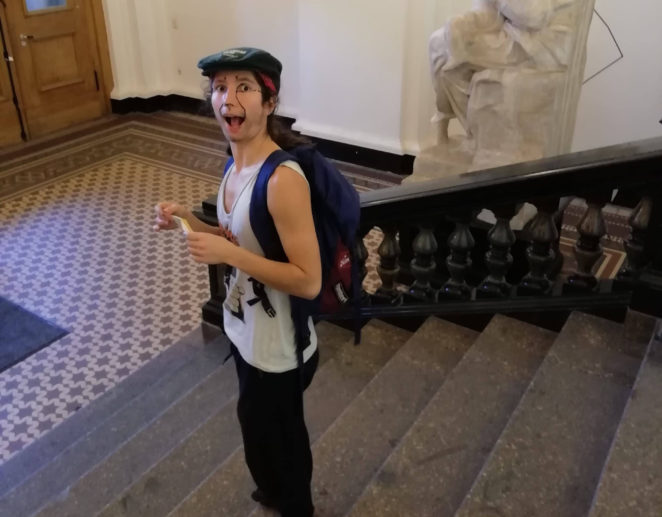
Photo courtesy of Ilai Elias Ilukka
As a kid, my first source of inspiration was nature and animals. I was exploring the first and mimicking the second that has inspired my dancing together with Michael Jackson. I have been inspired somewhat equally by “Vibrant matter” from Jane Benett than by Tolkien, Božo Vrećo, J.K Rowling as much as Joseph Kossuth, Beuys and Robert Fillou, Ara Malikian, David Garett and Yehudi Menuhin as well as Lindsey Stirling, my physiotherapist. Wagner, Béla Bartók, my friend Laura, Antonín Dvořák and Schoenberg, Lewis Caroll, Rob Zombie, CMX Tuomari Nurmio, Korpiklaani, Turisas for the war paint, Steam Power Giraffe, Serj Tankian, Megadeth, Klaus Nomi, NIna Hagen, Rammstein and so many others. Gérard Gasiorowski, Thomas Hirshhorn and Kurt Schwitters have been following me all along my bachelor years. I discovered Henri Darger, Stanisław Szukalski and Sergei Polunin with enthusiasm more recently. I never could make a difference between “Serous art” and “Pop culture/teenage stuff” in my practice and it is during my master degree in Helsinki I have been able to let them feed me both without the weird “this is not true-art” guilt I had maybe coming from a cultured artsy family.
Nevertheless, if I would have to choose only one, it would be Tom Waits.
What are you favourite exhibition spaces and why?
I took part in an exhibition in Helsinki (Changeful Me) where my piece was set in the cutest staircase and narrow corridor with pipes in Oksasenkatu 11 and it was just perfect.
Tiny staircases, awkward dead ends, walls with pipes or anything that isn’t white and neat. I liked them at first because they are generally more available than others. That fondness came from a need but became then something beyond that. I feel the space identity is participating a lot in how I will perform or set up. I don’t dance and do the same makeup regarding the type of floor I have to perform on and for the installations, they are really given a soul by where they are made. And uneasy spaces who already have a strong personality don’t make the challenge harder, just the story more interesting. I like to think I can be, produce and perform wherever. This “wherever” will just have me to tell something else than usual.
What could we hear about you in next 1-2 years? What are your future plans?
I have no idea, to be honest. If someone, two years ago, would have told me that I would be performing with the violin, be called a “dancer”, be able to casually draw simultaneously with two hands, play some piano, guitar at a rather decent level and win that award, when even entering Kuvataideakatemia sounded like a dream, I would probably have suggested that that this person should stop taking drugs and be realistic.
But it happened. So I really can’t tell.
One thing I can tell is that in two years, I should hopefully be stronger, more flexible, better with ballet shoes, guitar and violin. My singing voice will change with testosterone, so I will have to discover and work with a new deeper voice of mine. My art should be more free of my gender issues for I would look more like a man and see everything from a slightly different angle. However, one thing that can not be expected from me is to dress and behave like an average man which I would never manage. When I have more hair on my chin and chest, I plan to buy a leotard, perform with high heels and do my best as an artist to apply for a world where, the way one dresses, with whom has sex or which gender one wants to claim would be accepted and embraced with joy, peace and freedom. Even tolerant people have trouble understanding that a man born female is troubled with the clichés of masculinity even more than men born male.
In my opinion, the first step to broaden oneself is to realize how narrow we can still be and work against it.
